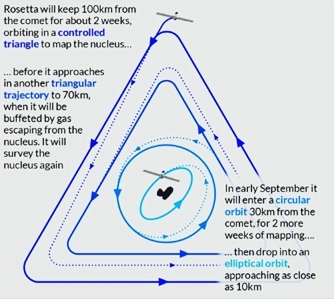![]() LATEST! ESA Rosetta mission ended like planned as it falled upon comet 67P/Churyumov-Gerasimenko on September 30th, 2016. Confirmation of the end of the mission arrived at ESA’s control center in Darmstadt, Germany at 11:19 GMT (13:19 CEST) with the loss of Rosetta’s signal upon impact. A final maneuver had occurred some 27 hours before, setting the probe on a collision course with the comet from an altitude of about 11.8 miles (19 km). The descent gave Rosetta the opportunity to study the comet’s gas, dust and plasma environment very close to its surface, as well as take very high-resolution images. The crash was decided also because a imminent month-long period of a conjunction of Rosetta relative to the Sun, rendering communications with the craft increasingly difficult and the comet heading out beyond the orbit of Jupiter back. last update: 10/3/2016
LATEST! ESA Rosetta mission ended like planned as it falled upon comet 67P/Churyumov-Gerasimenko on September 30th, 2016. Confirmation of the end of the mission arrived at ESA’s control center in Darmstadt, Germany at 11:19 GMT (13:19 CEST) with the loss of Rosetta’s signal upon impact. A final maneuver had occurred some 27 hours before, setting the probe on a collision course with the comet from an altitude of about 11.8 miles (19 km). The descent gave Rosetta the opportunity to study the comet’s gas, dust and plasma environment very close to its surface, as well as take very high-resolution images. The crash was decided also because a imminent month-long period of a conjunction of Rosetta relative to the Sun, rendering communications with the craft increasingly difficult and the comet heading out beyond the orbit of Jupiter back. last update: 10/3/2016
Launched on March 2nd, 2004 atop a Ariane-5 G+ launcher, Rosetta is a ESA mission to rendezvous with Comet 67P/Churyumov-Gerasimenko and studying the nucleus of the comet and its environment for nearly two years. The comet, a short period comet, takes 6.6 years to orbit the Sun at speeds of up to 84,000 mph. A probe will also land on the comet's surface. Rosetta will be the first spacecraft to orbit a comet and land on its surface. The journey to the comet took 3 Earth gravity assisted maneuvers, which occurred in March 2005, November 2007 and November 2009 respectively. A gravity assisted flyby also occurred at Mars in February 2007. The mission also successfully passed, like planed at asteroid Steins in September 2008 then at Lutetia, a 83-mile wide asteroid, by July 2010 as both objects encountered at a relative speed of 32,400 mph (52,142 km/h). Lutetia, like often had had a existence of about 4.5 billion years as it is a so-called 'metal asteroid.' As the mission then headed away of a Sun, beyond the orbit of Jupiter, it was put into a record 957 days in hibernation since June 2011, thus the first spacecraft to fly close to Jupiter’s orbit using only solar cells as its main power source. Rosetta was reactivated Jan. 20, 2014 when the mission had come closer back to Sun and the enough solar energy was activating its solar arrays. A pre-programmed internal 'alarm clock' woke up the spacecraft. After warming up its key navigation instruments, it came out of a stabilising spin, and aimed its main radio antenna at Earth. Science and navigation cameras regularly acquired images to help define Rosetta’s trajectory to the comet as the craft made a series a series of maneuvers to prepare to the rendezvous on August 6th, 2014 as the mission will have then journeyed during 10 and a half years. After having reached the comet about 450 million kilometers from the Sun, Rosetta orbiter will image Churyumov-Gerasimenko during 18 months accompanying the comet approaching Sun and developping a tail. The Philae harpoon-firing lander will have been released and landed on the comet by November 2014. A closest to the Sun is forecast on Aug. 13, 2015 and the mission is scheduled to end on December 31st, 2015
The gravity-assisted maneuvers meant to have the probe enter an orbit similar to that of its destination comet. The comet has a elliptical 6.5-year orbit taking it from beyond the orbit of Jupiter to between the orbits of Mars and Earth at its closest to the Sun. The goal was to have Rosetta match the comet's pace and travel alongside it to within just 3 ft/s between them
 | A view of the trajectories the Rosetta mission will follow when accompanying comet 67P/Churyumov-Gerasimenko to the Sun (distances in kilometers; values in miles, from top to bottom and left to right: 62 miles, 44 miles, 19 miles, and 6 miles respectively). courtesy site 'Amateur Astronomy' |
Rosetta gets its name from the famous Rosetta stone that allowed to the deciphering of Egyptian hieroglyphics almost 200 years ago. Rosetta’s original target was comet 46P/Wirtanen, but after postponement of the initial launch a new target was set, Comet 67P/Churyumov-Gerasimenko. The Philae lander is named for the island in the river Nile on which a obelisk was found that had a bilingual inscription that enabled too the hieroglyphs of the Rosetta Stone to be deciphered. The Philae rover is to be controlled by the ESA's LCC in Köln, Germany and the SONC (Science Operations and Navigation Control) in Toulouse, France. Once landed and warmed, it should re-establish communication with Earth several hours later
At a mass of 1,450 lbd (2,900kg; including 835 lbs (1670kg) of propellant and 83 (165 kg) lbs of science payload and the Philae lander at 50 lbs (100kg), the Rosetta mission, or the lander, are carrying a suite of science instruments. Science payload was provided by scientific consortia from institutes across Europe and the United States as three instruments are NASA-funded and will be used to study comet from the orbiter. The lander is provided by a European consortium headed by the German Aerospace Research Institute (DLR)
The spacecraft instruments are the following:
Philae lander sports a 10 science instrument-package: